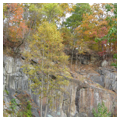Blue rock features prominently in Wilmington architecture. Geologist James Booth saw five major blue rock quarries around the city in his 1837–1838 travels, of which Clyde's and Gordon's were probably in this vicinity. In April 1885, the DuPont Company helped develop a large, modern quarry, operated by Locke and Company contractors, who had already extracted the stone for the nearby B&O Bridge (WL62) over the Brandywine. A total of 600,000 tons were removed in 1883–1888. A soaring, 180-foot-high aerial cable system was installed c. 1888 to swing blocks of stone from the quarry on the east bank to waiting Pennsylvania Railroad freight cars on the west. Starting in 1889, stockholder William M. Field oversaw the operation, providing stone for breakwater projects at Lewes (see Harbor of Refuge, ES26), Walnut Street Bridge in Philadelphia, and the railroad viaduct through Wilmington (WL10). In 1900, the quarry was 3,000 feet long and 2,000 feet wide, with walls 180 feet high. One hundred fifty men were employed in cutting 350,000 Belgian blocks for paving the streets of Camden, New Jersey. In addition, crushed stone was being sent to Forts Mott and Du Pont on the Delaware River. Today, all the quarries around Wilmington are abandoned, but the name Blue Rocks lives on as the local baseball team. A reconstruction of historic quarrying apparatus can be viewed on the grounds of the Hagley Museum (CH15). Now state-owned parkland, the Brandywine Granite Quarry site was opened to the public in 2004.
You are here
Brandywine Granite Quarry
If SAH Archipedia has been useful to you, please consider supporting it.
SAH Archipedia tells the story of the United States through its buildings, landscapes, and cities. This freely available resource empowers the public with authoritative knowledge that deepens their understanding and appreciation of the built environment. But the Society of Architectural Historians, which created SAH Archipedia with University of Virginia Press, needs your support to maintain the high-caliber research, writing, photography, cartography, editing, design, and programming that make SAH Archipedia a trusted online resource available to all who value the history of place, heritage tourism, and learning.







